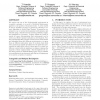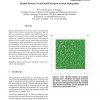78 search results - page 1 / 16 » Environment as a spatial constraint on the growth of structu... |
GECCO
2007
Springer
14 years 5 months ago
2007
Springer
We explore the use of the developmental environment as a spatial constraint on a model of Artificial Embryogeny, applied to the growth of structural forms. A Deva model is used t...
WIAS
2010
13 years 9 months ago
2010
Spatial agent models can be used to explore self-organising effects such as pattern growth and segregation. We employ our predator-prey model to study these emergent behaviours in...
HPCC
2005
Springer
14 years 4 months ago
2005
Springer
In this paper a new and powerful computer simulation capability for the characterization of carbonaceous nanoparticle assemblies across multiple, connected scales, starting from th...
VLDB
1998
ACM
14 years 3 months ago
1998
ACM
: Structural queries constitute a special form of content-basedretrieval where the user specifiesa set of spatial constraints among query variables and asks for all configurations ...
ILP
2005
Springer
14 years 4 months ago
2005
Springer
Clustering is a fundamental task in Spatial Data Mining where data consists of observations for a site (e.g. areal units) descriptive of one or more (spatial) primary units, possib...


